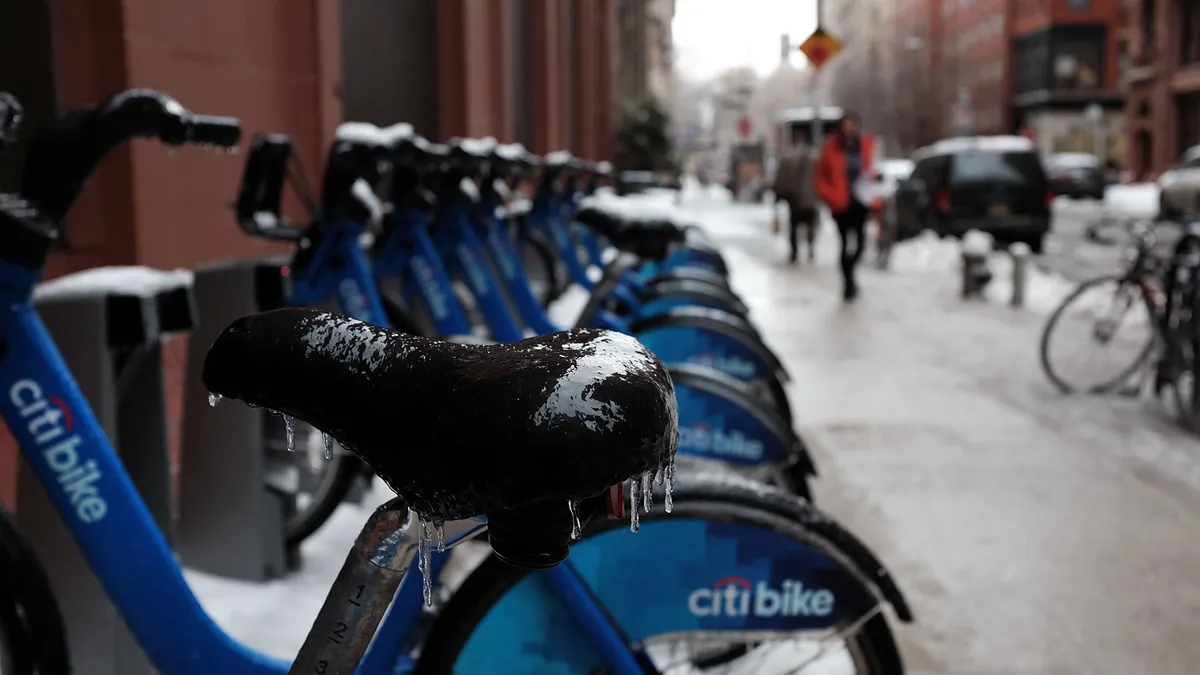Dive Brief:
- New York City's bikeshare program has become more inclusive in part through a community engagement strategy, expanded discount programs and the promotion of diverse leadership, according to a report released last week.
- The report details the work of the NYC Better Bike Share Partnership, a collaboration between the Bedford Stuyvesant Restoration Corporation (Restoration), Citi Bike, the NYC Department of Transportation (DOT) and the NYC Department of Health and Mental Hygiene. The coalition began in 2015 to expand the use of Citi Bike and shared micromobility among the minority residents of Brooklyn’s Bed-Stuy neighborhood.
- One of the partnership’s key successes was convincing Citi Bike to expand its discounted membership program, which had only been available to New York public housing residents and to recipients of Supplemental Nutrition Assistance Program (SNAP) benefits. In the first year of expanded eligibility starting in July 2018, 5,795 SNAP recipients and public housing residents purchased their first Citi Bike membership, a 257% increase from the previous year.
Dive Insight:
New York City launched its Citi Bike program in 2013, and its initial users were "overwhelmingly" white and male. The Better Bike Share Partnership was born in 2014 to "to increase access to and use of shared micromobility systems in low-income and BIPOC communities," the report writes.
Studies have shown that neighborhood perception is a key driver of bikeshare use; a 2019 study in the Transportation Research Part A journal found that minority and low-income neighborhood residents in Chicago viewed bikeshare installations as a sign of gentrification.
That was also a concern in New York, since Citi Bike originated in Manhattan and North Brooklyn. Even after docks were installed in Bed-Stuy, a 2015 survey found that just 18% of residents there had used one of the shared bikes. Restoration launched a concerted effort to put minority residents on bikes, starting group rides and education classes and prodding Citi Bike to redesign ads to better reflect the community.
The idea was not just to put Bed-Stuy residents on bikes, but to embrace bikeshare as an economic opportunity in the neighborhood. That meant spurring minority-owned businesses to find ways to partner with micromobility providers, encourage diverse candidates in the industry and pitch biking as a low-cost way to exercise.
"Restoration's mission is to close the racial wealth gap, and that takes on a lot of angles," said Alexis Harrison, program manager of the Center for Healthy Neighborhoods at Restoration. "We’re interested in biking for fun or biking as a trend, but also in the tangible benefits that the community can receive in terms of personal and financial health."
Beyond the perception issue, the partnership also worked to lower membership costs. The expansion of discounted SNAP memberships greatly widened the number of first-time riders across the city, and organizers also negotiated bulk memberships for employers. Still, despite the systemwide growth in first-time users, Bed-Stuy saw a 55% decrease in first-time members between July 2018 and July 2019. The report speculates that figure reflects a lack of expansion into Central Brooklyn and a shift in focus from direct community engagement to larger policy efforts.
Backers now hope that the Bed-Stuy model becomes a lesson for the future as New York offers new micromobility options, including e-scooters and mopeds. Lessons from other cities have shown that it takes more than simply putting vehicles in minority neighborhoods to encourage ridership; a recent evaluation of Chicago’s e-scooter pilot found that despite a requirement for scooter operators to keep half their vehicles in an equity priority area, only a quarter of trips started in those neighborhoods.
"As we expand Citi Bike in the Bronx, Queens, and Brooklyn, and introduce New Yorkers to shared e-scooters in the East Bronx, we will continue to rely on this partnership to ensure equity is at the center of our efforts, creating a more sustainable transportation network across the five boroughs," said NYC DOT Commissioner Hank Gutman in a statement.











